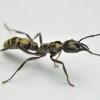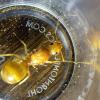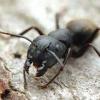The colony was caught March 20th in San Pedro, Nuevo Leon, Mexico. The original worker/brood to queen proportions where oddly low, with ~12 to 13 workers and a couple of eggs. At the time and as the time of posting there has been an extreme drought, which promptly lowered the leptogenys elongata populations immensely. I am unsure whether this colony is what remained of a larger one or if its a new young colony that split off.
- The total moments after being caught using an aspirator, they were nesting under a limestone beside a tree
- Ergatogyne queen, notice the smaller petiole and overall thicker abdomen.
 - Workers being active foragers despite their low numbers.
- Workers being active foragers despite their low numbers.

 - The setup, a plaster base covered with soil and a piece of brick for some climbing
- The setup, a plaster base covered with soil and a piece of brick for some climbing
I only managed to catch 6 workers and the queen because of their remarkable speed.
They've eaten many isopods to this day, eating over 4 the first days and being active foragers which is unusual for extracted Ponerines.
They reject any woodlice or termites and exclusively prey on pill bugs.
After about a dozen days, the eggs have hatched into larvae and the acclimation process appears to be almost 100% successful, with them actively hunting and foraging, as well as the queen laying more eggs and some eggs hatching and beginning to grow as larvae.
I believe the acclimation process was helped by the fact they were previously in terrible condition with next to no water or humidity. I will attempt to post some regular updates since this version of the species is exceptionally rare.
More pictures and video ( https://www.instagra...g_web_copy_link)

















